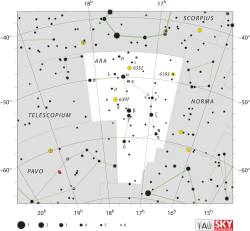| Observation data Epoch J2000 Equinox J2000 | |
|---|---|
| Constellation | Ara |
| Right ascension | 16h 56m 08.8405s[1] |
| Declination | –50° 40′ 29.244″[1] |
| Apparent magnitude (V) | 6.275[2] |
| Characteristics | |
| Spectral type | B3 Vnpe |
| U−B color index | –0.691[2] |
| B−V color index | +0.008[2] |
| Astrometry | |
| Radial velocity (Rv) | +19[3] km/s |
| Proper motion (μ) | RA: –7.66[1] mas/yr Dec.: –9.79[1] mas/yr |
| Parallax (π) | 5.06 ± 0.39 mas[1] |
| Distance | 640 ± 50 ly (200 ± 20 pc) |
| Absolute magnitude (MV) | −0.16[4] |
| Orbit[5] | |
| Period (P) | 236.50 ± 0.18 d |
| Inclination (i) | 60 ± 7° |
| Periastron epoch (T) | HJD 2458672.10 ± 0.72 |
| Semi-amplitude (K1) (primary) | 4.33 ± 0.05 km/s |
| Semi-amplitude (K2) (secondary) | 52.83 ± 1.49 km/s |
| Details | |
| ρ1 Ara A | |
| Mass | 6.5 ± 1.3[5] M☉ |
| Radius | 4.21 ± 0.20[6] R☉ |
| Luminosity | 1,418[7] L☉ |
| Surface gravity (log g) | 3.75[8] cgs |
| Temperature | 19,800[8] K |
| Rotational velocity (v sin i) | 370 ± 10[9] km/s |
| Age | 18.4 ± 1.5[10] Myr |
| ρ1 Ara B | |
| Mass | 0.53 ± 0.11[5] M☉ |
| Radius | 0.27 ± 0.04[6] R☉ |
| Luminosity | 204[6] L☉ |
| Temperature | 42,000[6] K |
| Other designations | |
| Database references | |
| SIMBAD | data |
Rho1 Arae is the Bayer designation for a star in the southern constellation of Ara. Unusually for a star with a Bayer designation, it was not catalogued by Bayer in his Uranometria. It was instead first catalogued by Nicolas Lacaille, in his Coelum Australe Stelliferum published in 1763. This star gained the Bayer designation of Rho1 Arae in Bode's Uranographia, published in 1801. Rho1 Arae is one of the dimmest stars with a Bayer designation, having an apparent visual magnitude of just +6.275[2] According to the Bortle Dark-Sky Scale, this means the star is just barely visible to the naked eye in dark rural skies. Based upon parallax measurements, it is about 640 light-years (200 parsecs) distant from the Sun, give or take a 50-light-year margin of error.[1]

The Hipparcos data revealed that Rho1 Arae is a variable star. It was given its variable star designation, V846 Arae, in 1999.[13] This is a spectroscopic binary system, which means that the presence of an orbiting companion is indicated by shifts in the spectrum. The primary star is a Be star, while the secondary star is a subdwarf O star; they orbit each other with a period of about 236.50 days.[5] The combined spectrum of this system matches a stellar classification of B3 Vnpe, which may indicate the primary is a B-type main-sequence star. The 'e' suffix indicates the presence of emission lines from the primary Be star. For Rho1 Arae, the emission lines are prominent and variable.[9] The primary star is spinning rapidly with a projected rotational velocity of 370 ± 10, which makes it difficult to obtain reliable orbital elements.[9]
Rho1 Arae has a peculiar velocity of 27.4 ± 4.9 km/s relative to its neighbors,[10] making it a runaway star system. A scenario that it was ejected from the Scorpius–Centaurus OB association as a result of a past supernova explosion seems unlikely because of its binarity.[9]
- ^ a b c d e f Cite error: The named reference
aaa474_2_653was invoked but never defined (see the help page). - ^ a b c d Cite error: The named reference
aass61_387was invoked but never defined (see the help page). - ^ Cite error: The named reference
rgcrvwas invoked but never defined (see the help page). - ^ Cite error: The named reference
Anderson2012was invoked but never defined (see the help page). - ^ a b c d Wang, Luqian; Gies, Douglas R.; Peters, Geraldine J.; Han, Zhanwen (April 2023). "The Orbital and Physical Properties of Five Southern Be+sdO Binary Systems". The Astronomical Journal. 165 (5): 203. arXiv:2303.12616. Bibcode:2023AJ....165..203W. doi:10.3847/1538-3881/acc6ca. ISSN 1538-3881.
- ^ a b c d Wang, Luqian; Gies, Douglas R.; Peters, Geraldine J.; Götberg, Ylva; Chojnowski, S. Drew; Lester, Kathryn V.; Howell, Steve B. (2021). "The Detection and Characterization of Be+sdO Binaries from HST/STIS FUV Spectroscopy". The Astronomical Journal. 161 (5): 248. arXiv:2103.13642. Bibcode:2021AJ....161..248W. doi:10.3847/1538-3881/abf144.
- ^ Cite error: The named reference
an331_4_349was invoked but never defined (see the help page). - ^ a b Cite error: The named reference
aaa515_A11was invoked but never defined (see the help page). - ^ a b c d Cite error: The named reference
apj721_1_469was invoked but never defined (see the help page). - ^ a b Cite error: The named reference
mnras410_1_190was invoked but never defined (see the help page). - ^ Cite error: The named reference
SIMBADwas invoked but never defined (see the help page). - ^ Cite error: The named reference
MASTwas invoked but never defined (see the help page). - ^ Cite error: The named reference
Kazarovetswas invoked but never defined (see the help page).
